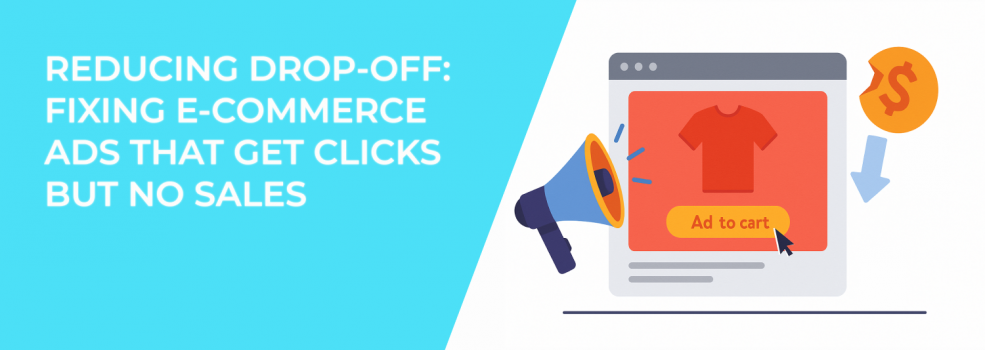Your ad is performing. The creative looks clean. Your CPC is reasonable. Clicks are rolling in.
But when you look at conversions — nothing.
It’s a frustrating but common issue in e-commerce advertising: your Facebook or Instagram ads attract attention but fail to generate sales. Something is happening between the click and the checkout — and it’s hurting your ROAS.
Below, we’ll explore less obvious reasons behind post-click drop-off, and walk through practical, research-backed strategies to help you fix it.
1. Start With Tight Message Alignment
When there’s a disconnect between what your ad says and what your landing page shows, users lose trust — fast.
Even if you're sending them to the right product category, subtle mismatches (in tone, images, or even pricing) can cause friction.
What to do to improve message match:
-
Mirror the language and promise from your ad in the headline of your landing page.
-
Avoid linking to generic collection or homepage URLs. Instead, build specific pages for key offers or campaigns.
-
Use visual consistency — keep your product photos, fonts, and color palette similar between the ad and landing page.
If your ad says “50% Off Limited-Edition Backpacks,” your landing page should highlight the exact backpack — not a mix of categories — and show the discount clearly above the fold.
Message mismatch is a silent killer. It’s one of the first things to fix before you start looking deeper into performance issues. For more ways to catch these misalignments, see Facebook Ads Not Converting: How to Fix It.
2. Fix Slow or Poorly Optimized Pages (Especially on Mobile)
Site speed isn’t just a technical metric — it directly affects your bottom line. According to Google research, 53% of mobile visitors abandon sites that take longer than 3 seconds to load.
That’s especially damaging when you’re paying for each visitor.
What to fix first:
-
Compress large images without losing quality.
-
Prioritize loading critical assets first, like your CTA and product visuals.
-
Use lazy loading for non-essential sections (e.g., reviews, blog posts, related products).
-
Check mobile layout thoroughly — especially buttons, carousels, and popups.
If mobile performance isn’t strong, you're not just losing conversions — you're weakening retargeting signals and damaging your algorithmic learning.
Struggling with audience quality or shrinking reach due to slow post-click behavior? You might want to read Why You See 'Ad Set May Get Zero' on Facebook and How to Fix It, which outlines how poor engagement can throttle your impressions.
3. Make the Journey Simpler — Not Just Prettier
A beautiful landing page isn’t always an effective one. If users can’t quickly figure out what they’re looking at, why it matters, and what to do next, they will bounce.
Essentials of a high-converting page:
-
Clear value prop above the fold, not buried in tabs or sliders.
-
One strong CTA per screen — and not too many competing buttons.
-
Trust signals like “Free Returns,” “Verified Reviews,” or “Ships in 24 Hours,” visible early on.
-
No distracting popups unless they’re behavior-triggered (e.g., exit intent or scroll-depth based).
Let’s say a user clicks through from an Instagram ad promoting a minimalist watch. They land on a page full of technical jargon, with CTAs hidden below testimonials and a shipping info banner. The friction builds — and the sale dies. Instead, lead with the benefit, show the product clearly, and make it painfully obvious how to buy.
4. Build Confidence With Social Proof and Buyer Reassurance
For first-time visitors — especially those unfamiliar with your brand — you’re asking a lot by expecting a purchase. Without trust, you’re likely to lose them.
Add visible trust-builders, such as:
-
Photo-based customer reviews, ideally featuring user-generated content.
-
Short shipping and returns policy summaries, near the add-to-cart button.
-
Subtle risk reversal cues like “30-day money-back guarantee” or “secure checkout.”
-
Live chat widgets or AI-powered assistants, which provide real-time reassurance.
Users may not scroll down to find answers — so surface the most important ones near the top. Consider including a section like “What Happens After You Order?” to make the process feel transparent and safe.
Struggling to determine which reassurance points matter most to your audience? It might be time to revisit your targeting. Check out Facebook Ad Targeting 101: How to Reach the Right Audience to refine your audience building.
5. Segment Retargeting Campaigns Intelligently
When someone doesn’t buy, you still have a second chance — but only if your retargeting is thoughtful. Too many advertisers hit everyone with the same dynamic product ad, regardless of behavior.
Instead, retarget based on specific user signals:
-
Product viewers who didn’t add to cart → show product reviews or lifestyle images.
-
Cart abandoners → show urgency (“Only 3 left”) or perks (“Free shipping if you order today”).
-
People who spent time reading FAQs → highlight support, guarantees, or return policies in your creative.
Even better, go beyond site behavior. Retarget people who engaged with your Instagram Reels or saved a product post — these warm touches often outperform website-based retargeting.
Need help setting this up properly? Our guide on How to Set Up Facebook Retargeting walks you through the entire process, from pixel events to creative strategy.
6. Add a Low-Friction Action for Undecided Shoppers
If your product is considered, personal, or priced over $50, many users won’t convert immediately. That doesn’t mean they’re a poor lead — it means they’re not ready yet.
Offer something between “browse” and “buy”:
-
Email opt-in with a small first-purchase discount.
-
“Save for later” wishlist or reminder feature.
-
Interactive quiz to recommend a best-fit product.
Not only do these increase engagement, but they also allow you to build warm audiences for future retargeting. And you can use tools like Facebook’s custom audiences to reach them again with relevant messages.
To get started building these precise user groups, read How to Define a Target Audience for Marketing: a Step-by-Step Guide.
Final Thoughts: Optimize Beyond the Ad
Getting a click is no longer the hard part. The real work — and the most valuable optimization — happens after someone lands on your site.
To reduce drop-off:
-
Review and tighten message alignment.
-
Optimize for both page speed and perceived load time.
-
Simplify the on-site experience, especially on mobile.
-
Reinforce buyer confidence at every step.
-
Retarget based on what users did, not just the fact that they visited.
-
Offer alternate paths for warm, hesitant shoppers.
Fixing this gap between click and conversion can transform how your campaigns perform — and how sustainable your customer acquisition costs become.

